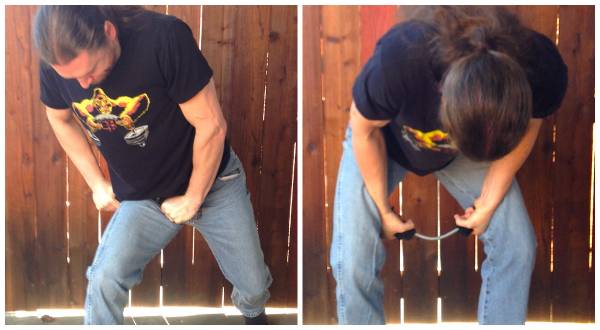If someone asked you to bend a nail, you’d probably brace the object against some part of your body, typically your leg. The brace acts as a fulcrum from which you apply the pressure on each side of the object. This is called braced bending, and it is what this article will teach you how to do.
Braced bending is different from short bending, which I showed you in my previous article on nail bending. Short bending is done away from the body, and all the power is generated through the hands. But even though you use a fulcrum, braced bending is not easy. You still need hand and wrist strength, even though other parts of the body come into play. This will be described more as we get into the details of technique.
Braced bending is typically performed with objects in the 8” to 12” range. When you go longer than that, you’ll still be bracing the object against something, but you may create multiple bends. This is called scrolling steel, and is considered a different feat of strength altogether.
Brace and Bend
The most common brace is the thigh. Note that this hurts. You’re applying a lot of pressure on the object, which then digs into your leg. You can place a pad or a rolled up hand towel on your thigh to help, but it will still be painful. Jeans seem to disperse some of the pain a bit more than other clothing. Get used to it. Part of being a strongman is developing a high pain tolerance.
- Wrapping the Spike: Wrap the head and point of the spike in leather or other wraps, just as in short bending. A tight wrap is still useful, though not as important here.
- Leg Position: Take a slight lunge position. The leading leg is whichever leg you prefer the spike to be braced against. I like to go with my right leg, but experiment to find which one works best for you.
- Grip Position: Grasp the wrap at the far ends of the spike. Your hands should be as far to the edge of the spike as possible, but the majority of the hand should be over the spike and not hanging off the ends.
- The First Bend: Explode into the nail with the upper body and arms. Press down as hard as you can on both ends of the nail. The nail will begin to bend around your leg. You must be able to resist the pain so you can push hard enough to bend the object. Tricep strength comes into play. Keep a slight bend in your arms and bend from the waist. Think of an explosive bench press and sit up at the same time, all directed into the steel.
- The Next Position: Once you have a sufficient kink in the spike (aim for at least a 30 degrees), you’ll switch to the next position. Reposition your body but keep your hands on the outside ends of the nails. Place your feet at minimum shoulder width apart but turn your feet and knees outward. Place the spike between the insides of your thighs, with the wrists backed up against your legs.
- The Second Bend: Once you’re in position, start torqueing with your wrists to begin the bend. Your legs apply inward pressure against the wrists to assist with the bend. Don’t just press inward, but torque that pressure towards the kink in the spike to drive all the power into the weak point. It may seem like the legs do most of the work here, but wrist strength will make or break your ability to accomplish this.
- The Final Bend: Finish the bend in this position. If you need to, step your feet in closer to each other to provide more leverage. You can also bring the spike up to a double overhand position, like in short bending, to finish the close.

Right: the first bend; Left: the second bend
Progress to Wrenches and Screwdrivers
Start to learn this feat with a 12” spike. Once you’re good there, you can move on to 10” spikes. This is a pretty big jump in difficulty. Like other feats of strength, the difficulty will change depending on the quality of the steel used. In my experience, galvanized nails – those with a zinc coating – are easier than non-galvanized.
Once you’ve mastered the 10” spike, you can move on to other objects that can be bent in the same way. Thick screwdrivers, hammers, and even wrenches. Bending these common household objects with your hands is a stunning feat to the average person. Turning a brand-name wrench into an “S” shape with just two bends is one of the feats that put grandmaster strongman Dennis Rogers on the map.
Braced bending takes strong hands and a strong body, as well as a large degree of pain tolerance. But if you master it, you’ll be able to perform a feat of strength few can match.
More like this:






